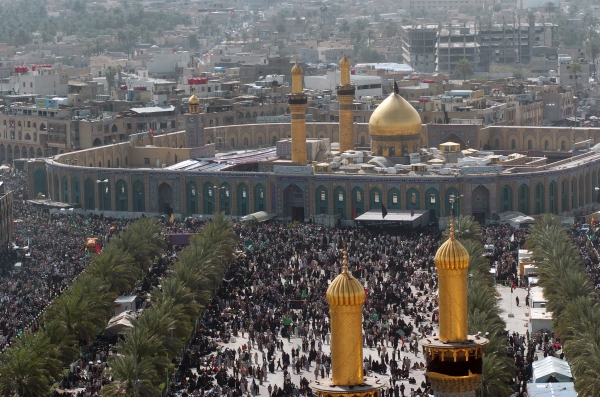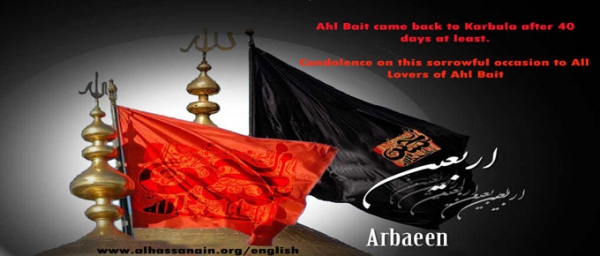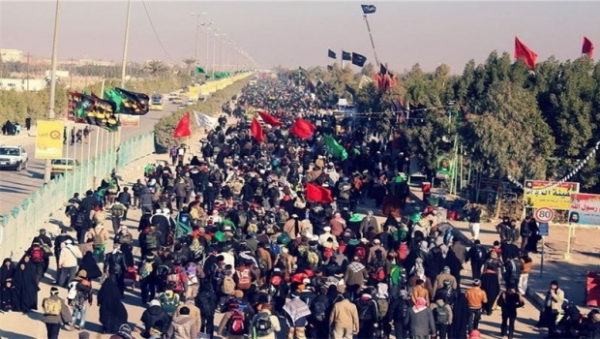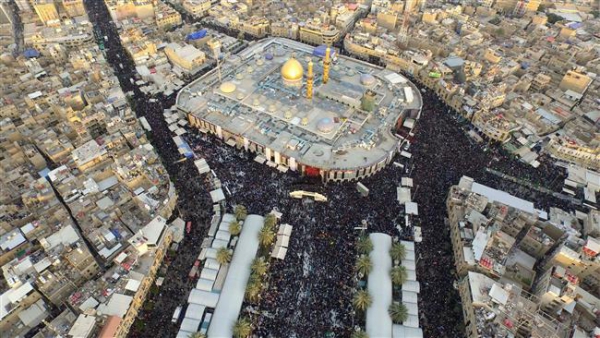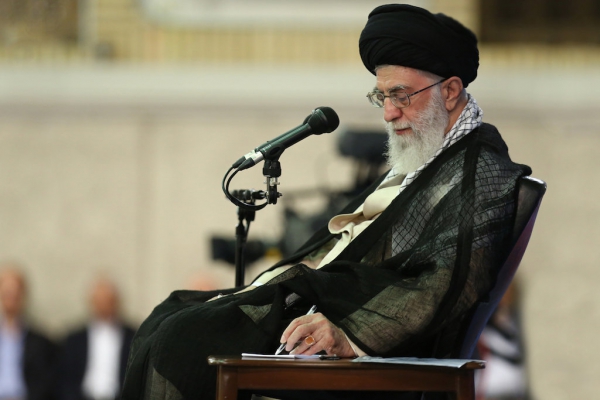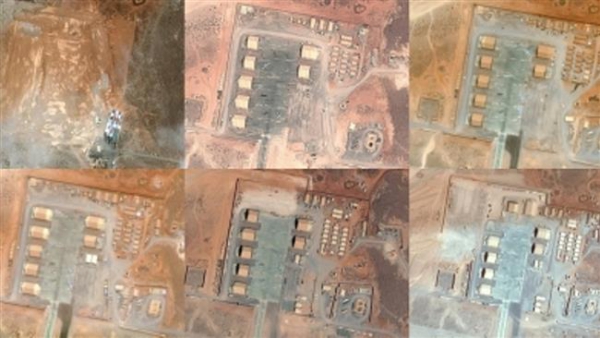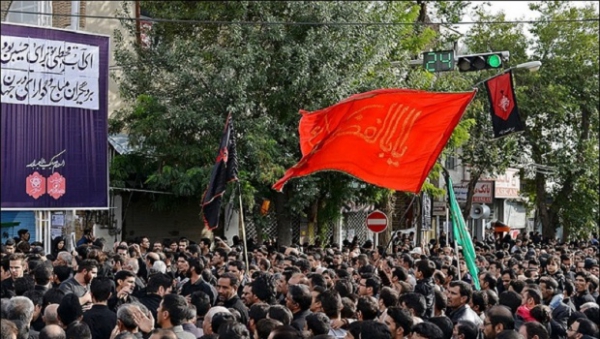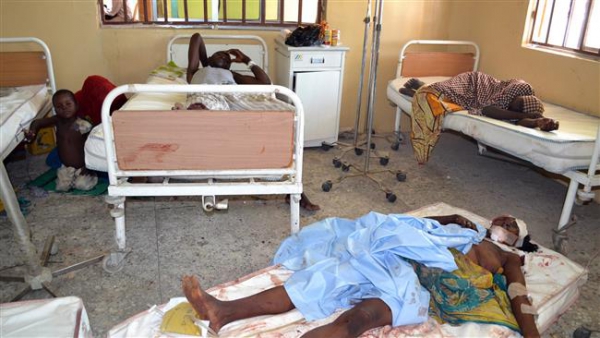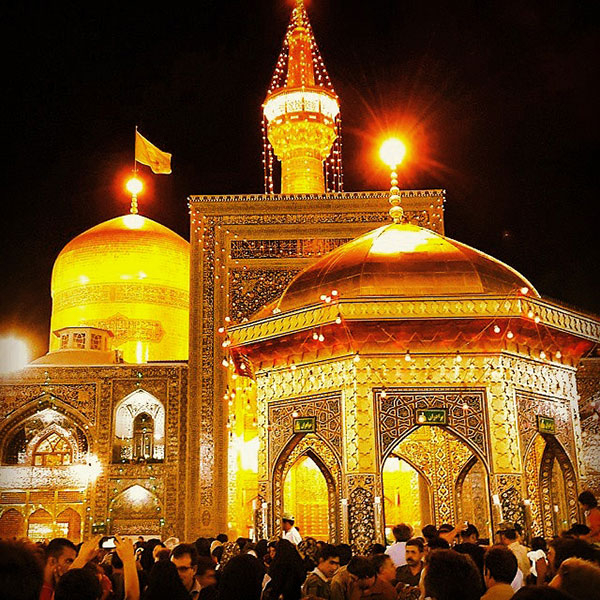hasania
20th Safar- Arbaeen Ziarat
According to Imam Hasan bin Ali Al Askari (as) The signs of a true believer are five:-
1) Recite 51 Rak—a’t Salaat during the 24 hours of the day (17 Rak—a’ts obligatory, + 34 Rak—a’ts in Naafilah Salaats).
2) Be in Karbala for Ziyarat of Imam Husayn (as)/other martyrs, or at least recite Ziyarat of the Holy Imam as given below
3) To wear a ring in the right hand.
4) To put the forehead on the earth (preferably on the earth of Karbala) in prostration.
5) To pronounce “Bismillahir-Rah’maanir-Rah’eem” in clear and loud voice while praying the salats.
The Purpose of Imams mission is very well summarised in this ziarat as "...made every effort and put his heart, mind, soul and life at the disposal of Thy mission to liberate the people from the yoke of ignorance"
It reads:
Peace be on the favorite of Allah, Peace be on the beloved friend of Allah, His distinguished hero! Peace be on the choicest confidant of Allah, sincerely attached precisely like his father! Peace be on Hussain, who gave his life in the way of Allah, a martyr, underwent untold hardships Peace be on the hostage surrounded by the-tightening circle of sorrow and grief, killed by a horde of savages.
O my Allah I give witness that beyond a shadow of doubt he is Thy favorite and choicest confidant, who enjoys Thy confidence and favor, precisely like his father!
Thou looked upto him and elected him in Thy cause, picked and chose him for the good fortune, selected for him the best purified parents, appointed him guardian, leader, and defender of rights, a true representative (inheritor and progenitor) of guardians, leaders and defenders of rights, gave him much and more from the inheritance of the Prophets, put him forward as a decisive argument, along with the other successors (of the Holy Prophet-the twelve lmams) to the mankind. He met with deadly dangers, acted justly and fairly, made use of everything belonging to him to pay full attention to give sincere advice, took pains, made every effort and put his heart, mind, soul and life at the disposal of Thy mission to liberate the people from the yoke of ignorance and evil of bewilderment, but an evildoer, deceived with empty hopes of mean and worthless worldly gains, had pressed heavily on him, and sold out his share (eternal bliss) for the meanest and lowest bargain, betrayed his "day of judgment" for a vulgar return, took pride in insolence, fell into the fathom- well of silly stupid follies, provoked Thee and Thy Prophet to anger, did as the harsh discordant, the hypocrite, the heavily burdened bearers of sin, condemned to Hellfire, advised to him, however, he (the Holy lmam), steadily, rightly and justly coped With them, till, in Thy obedience, gave his life after which his family was set adrift.
O my Allah, therefore, condemn them to hell as a denunciation and conviction; and crack-down on them with a painful Punishment. Peace be on you O the son of the Messenger of Allah! Peace be on you O the son of the first of the successors (of the Holy Prophet)! I bear witness that Allah put faith in you like He had full confidence in your father, and that you always looked for and collected good and virtue, lived a highly praiseworthy life and departed from this world a martyr, forsaken and abused; I bear witness that Allah will promptly fulfill the promise, He made to you, and destroy those who left you helpless and punish those who killed you; I bear witness that you kept your promise made with Allah, and strived in His way till what was certain came upon you, so curse of Allah be an those who killed you, curse of Allah be on those who oppressed you, curse of Allah be on the people who came to know and approved.
O my Allah be my witness that I make friends with those who love him and oppose those who deny him. I, my father and mother, are at your disposal 0 the son of the Messenger of Allah. I know and bear witness that you were "light" in the sublime loins and in the pure wombs, never touched you the dirt of ignorance, nor ever obscurity concealed you in its folds;I bear witness that you are the pillar of "Deen", support of the Muslims, refuge of the faithful; I bear witness that you are a truthful, well-aware, content, intelligent, rightly guided guide (Imam); I bear witness that the Imams among your descendants are the symbols of "conscious piety" and signs of "true guidance",
the "safe handle"-Islam, and the decisive arguments over mankind; I declare positively that I have full faith in you and I know for certain that you shall return. I am, fully committed to the laws of my religion, certain of my deeds, my mind and heart ready for your return, and my affairs carried out in the light of your instructions, till Allah gives you permission, together with you, along with you, not at the same time with your enemies. Blessings of Allah be on you, on your souls, on your bodies when you are visible, when you are invisible, on your perceivable aspects, on your innermost genius be it so, O Lord of the worlds
The Story of Arbaeen (40th Day after martyrdom of Imam Husayn (AS))
The moon was almost setting, casting its dying rays on the waters of the rivulet Al Quma and the few tents that were pitched on its banks. Beside these tents, there were a few graves, which were scattered over some distance, providing the only landscape, which the lunar beams could light up dimly.
The stillness of the night was almost suffocating. The only noise that could be heard for miles around was the chirping of the night insects and the monotonous rippling of the waters of the stream, which recounting the mournful events of the day that had seen the death of those who lay buried in the nearby graves.
Suddenly there was a stir one of the tents, as if somebody had been awakened from his sleep. The flap of the tent was lifted and an old man, walking with a bent back and supporting himself in a staff, came out of it followed by a young person who apparently was his valets or orderly. Slowly he advanced towards the other tents and, standing a few paces away, shouted for the inmates of the other tents to come out.
Apparently the old man was speaking with a tone of authority as, hearing his voice the other persons sleeping in the tents rushed out showing obvious concern for his safety and welfare. He seemed to their leader or chieftain as they reverentially addressed him with bent heads.
One of these persons, who perhaps was closer to him, a friend if not a blood relation and quite advance in age, came hurriedly to where the old man was standing and said: O' Jaber (r), what is the matter with you that you woke up so early before the break of dawn? May Allah bless you and your noble revered father, we all felt frightened by the thought that some illness had come to you some pain had awakened you from your sleep. Pray tell us the cause of your perturbation, if it is not connected in any way with your health.
The old man was no other than Jaber Ibn Abdullah Ansari (r). He had on hearing about martyrdom of Imam Husayn (a.s) and his companions and the imprisonment and humiliation of the surviving members of his family hastened towards Karbala with his devoted friends and follower. He had heard that bodies of the martyrs of Karbala were left without any burial.
On reaching Karbala, he saw that the Bani Asad who were having their nomadic camps some distance away from Karbala have covered the bodies with sand to protect them from ravages but no proper burial had been given to the martyrs. Jaber (r), with the help of his friends prepared the graves of the martyrs.
Jaber Ibn Abdullah (r) explained to his friends and companions that the reason why he had awakened them so early that morning was that in his dream he had seen the Holy Prophet who had told him the captives caravan, comprising Ali Zainul Abedeen (as), his infant son Muhammad al Baqir (as), Husayn (as)'s sisters were to reach Karbala that morning. The Prophet had asked him to go forward to greet them and to convey to them his salaams and condolences. He told his friends that he had awakened after this and he wanted them to accompany him so that they could go forward to receive the caravan and play hosts to the family of the Prophet (pbuh).
By this time the first streak of dawn was visible on the eastern horizon. One of the entourage of Jaber (r) recited the call to prayers and all offered their morning prayers and thanked Almighty Allah for giving them the opportunity of being nor only the first pilgrims at the graves of the martyrs of Karbala, but also the first ones to greet the family of the prophet (pbuh) on their return visit to the land rendered scared by the Holy blood of the martyrs.
As soon as they finished the prayers than they saw a cloud of dust rising in the distant horizon, indicating the approach of a caravan. Jaber (r) and his friends rode their mounts to receive and welcome the Prophet (pbuh)'s family. As soon as they were at a hailing distance, they got down from their steed and, with profound respect offered their salutation to Imam Ali Zainul abadeen (as).
Jaber went over to the imam and holding the bridle of his horse respectfully led him towards his camp on the banks of the river with the rest of the caravan following them. He told the Imam about the purpose of his visit to Karbala what he had seen and heard during his halt there, and what he had done. He also respectfully enquired from Imam Zainul abadeen (as) about treatment meted out to him and the ladies of the prophet (pbuh)'s family. When this question was put to him the Imam wept silently for quite some time and then softly replied:
"O' Jaber it is a story of sufferings which will be written in blood and tears for future generations to read! What suffering shall I recount to you, which we endured after the tragedy here? The defy description".
When the women of the family of the Prophet saw the graves of their dear ones, they fell one by one from their camels, overcome by grief and sorrow. Each one rushed towards the grave of her son, brother, father or husband. Each lady poured her heart over the grave of her dearest departed relation, narrating all the sufferings she endured. Zaineb (a) darted straight towards grave of Husayn (as).
Zaineb (a) was heard to say on Imam Husayn (as)'s grave: "My beloved brother, I have returned to you but without Sakina (a), whom you had at the time of departing entrusted to my care. My dearest brother, your beloved Sakina (a) bore all the suffering mutely and with fortitude till she could no longer endure them and surrendered her soul to her Maker. Forgive me my dear brother, if I faltered in any way in fulfilling the mission you entrusted to me."
This incident occurred 40 days after the martyrdom of Imam Hussein. Ever since that incident, the followers of Imam Hussein commemorate that incident each year by gathering and remembering the tragedies that Imam Hussein and his family went through on the day of Ashura and the 40 days following Ashura.
Iran seeking to put Arba’een massive March on UNESCO Heritage list
Head of Iran’s Cultural Heritage, Handicrafts and Tourism Organization (ICHHTO) Masoud Soltanifar said the country plans to get the massive march of pilgrims on Arba’een inscribed on UNESCO’s World Heritage List.
During a cabinet meeting on Sunday, Soltanifar emphasized that in coordination with neighboring Iraq, Iran is making efforts to place the massive march staged by millions of pilgrims for Arba’een on UNESCO’s World Heritage List as “an Islamic spiritual heritage”.
During the meeting, President Hassan Rouhani also pointed to the huge influx of Iranian pilgrims to Iraq, saying that throughout the history of Islam, the followers of Ahl-ul-Bayt (the family of Prophet Muhammad (SAWA)) have kept this tradition (Arba’een ceremony) alive.
He went on to say that in recent years, the Arba’een rites have been held with more glory and grandeur.
Each year, millions of pilgrims flock to Karbala, where the holy shrine of Imam Hussein (AS) is located, to perform mourning rites.
Last year, around 20 million pilgrims from all over the world gathered in Karbala to attend the mourning ceremonies marking Arba’een.
Millions of mourners preparing for Arba’een rituals in Iraq's Karbala
Millions of people from across the world are converging on the holy Iraqi city of Karbala to take part in mourning rituals on Arba’een, the day which marks 40 days after the martyrdom anniversary of the third Shia Imam, Imam Hussein (PBUH).
Pictures coming out of Iraq show black-clad pilgrims taking part in a march toward Karbala, located about 100 kilometers south of the Iraqi capital of Baghdad, to show their commitment to the Shia Imam with many walking barefoot.
Iraqi forces have tightened security around Imam Hussein’s shrine to protect pilgrims against possible terrorist attacks ahead of the mourning rituals on Thursday.
The northern and western parts of Iraq have been plagued by gruesome violence ever since Daesh terrorists began their campaign of terror in the country in June 2014. Army soldiers and Popular Mobilization units have joined forces and are seeking to take back militant-held regions in joint operations.
Meanwhile, millions of Iranians across the country are also preparing to mark the occasion by holding mourning rituals on Wednesday. Millions of Iranians have also traveled to Iraq to take part in Arba'een march and attend mourning ceremonies in Karbala.
Imam Hussein and 72 of his loyal companions, including family members, were martyred on Ashura, the tenth day of the lunar month of Muharram, in the battle of Karbala against the second Umayyad caliph, Yazid I, in 680 A.D. Imam Hussein was killed after he refused to pledge allegiance to the tyrant ruler.
A quick review of Ayatollah Khamenei's 2nd letter to the youth in Western countries
In reaction to Paris Attacks, Leader of the Islamic Revolution of Iran has written down a second letter addressing the youth in Western countries.

The bitter events brought about by blind terrorism in France have once again, moved me to speak to you young people
In the Name of God, the Beneficent, the Merciful
To the Youth in Western Countries,
The bitter events brought about by blind terrorism in France have once again, moved me to speak to you young people. For me, it is unfortunate that such incidents would have to create the framework for a conversation, however the truth is that if painful matters do not create the grounds for finding solutions and mutual consultation, then the damage caused will be multiplied.
The pain of any human being anywhere in the world causes sorrow for a fellow human being. The sight of a child losing his life in the presence of his loved ones, a mother whose joy for her family turns into mourning, a husband who is rushing the lifeless body of his spouse to some place and the spectator who does not know whether he will be seeing the final scene of life- these are scenes that rouse the emotions and feelings of any human being. Anyone who has benefited from affection and humanity is affected and disturbed by witnessing these scenes- whether it occurs in France or in Palestine or Iraq or Lebanon or Syria.
Without a doubt, the one-and-a-half billion Muslims also have these feelings and abhor and are revolted by the perpetrators and those responsible for these calamities. The issue, however, is that if today’s pain is not used to build a better and safer future, then it will just turn into bitter and fruitless memories. I genuinely believe that it is only you youth who by learning the lessons of today’s hardship, have the power to discover new means for building the future and who can be barriers in the misguided path that has brought the west to its current impasse.
Anyone who has benefited from affection and humanity is affected and disturbed by witnessing these scenes- whether it occurs in France or in Palestine or Iraq or Lebanon or Syria.
It is correct that today terrorism is our common worry. However it is necessary for you to know that the insecurity and strain that you experienced during the recent events, differs from the pain that the people of Iraq, Yemen, Syria and Afghanistan have been experiencing for many years, in two significant ways. First, the Islamic world has been the victim of terror and brutality to a larger extent territorially, to greater amount quantitatively and for a longer period in terms of time. Second, that unfortunately this violence has been supported by certain great powers through various methods and effective means.
Today, there are very few people who are uninformed about the role of the United States of America in creating, nurturing and arming al-Qaeda, the Taliban and their inauspicious successors. Besides this direct support, the overt and well-known supporters of takfiri terrorism- despite having the most backward political systems- are standing arrayed as allies of the west while the most pioneering, brightest and most dynamic democrats in the region are suppressed mercilessly. The prejudiced response of the west to the awakening movement in the Islamic world is an illustrative example of the contradictory western policies.
I genuinely believe that it is only you youth who by learning the lessons of today’s hardship can be barriers in the misguided path that has brought the west to its current impasse.
The other side of these contradictory policies is seen in supporting the state terrorism of Israel. The oppressed people of Palestine have experienced the worst kind of terrorism for the last sixty years. If the people of Europe have now taken refuge in their homes for a few days and refrain from being present in busy places- it is decades that a Palestinian family is not secure even in its own home from the Zionist regime’s death and destruction machinery. What kind of atrocious violence today is comparable to that of the settlement constructions of the Zionists regime?
This regime- without ever being seriously and significantly censured by its influential allies or even by the so-called independent international organizations- everyday demolishes the homes of Palestinians and destroys their orchards and farms. This is done without even giving them time to gather their belongings or agricultural products and usually it is done in front of the terrified and tear-filled eyes of women and children who witness the brutal beatings of their family members who in some cases are being dragged away to gruesome torture chambers. In today’s world, do we know of any other violence on this scale and scope and for such an extended period of time?
Shooting down a woman in the middle of the street for the crime of protesting against a soldier who is armed to the teeth- if this is not terrorism, what is? This barbarism, because it is being done by the armed forces of an occupying government, should not be called extremism? Or maybe only because these scenes have been seen repeatedly on television screens for sixty years, they should no longer stir our consciences.
The military invasions of the Islamic world in recent years- with countless victims- are another example of the contradictory logic of the west. The assaulted countries, in addition to the human damage caused, have lost their economic and industrial infrastructure, their movement towards growth and development has been stopped or delayed and in some cases, has been thrown back decades. Despite all this, they are rudely being asked not to see themselves as oppressed. How can a country be turned into ruins, have its cities and towns covered in dust and then be told that it should please not view itself as oppressed? Instead of enticements to not understand and to not mention disasters, would not an honest apology be better? The pain that the Islamic world has suffered in these years from the hypocrisy and duplicity of the invaders is not less than the pain from the material damage.
Dear youth! I have the hope that you- now or in the future- can change this mentality corrupted by duplicity, a mentality whose highest skill is hiding long-term goals and adorning malevolent objectives.
Dear youth! I have the hope that you- now or in the future- can change this mentality corrupted by duplicity, a mentality whose highest skill is hiding long-term goals and adorning malevolent objectives. In my opinion, the first step in creating security and peace is reforming this violence-breeding mentality. Until double-standards dominate western policies, until terrorism- in the view of its powerful supporters- is divided into “good” and “bad” types, and until governmental interests are given precedence over human values and ethics, the roots of violence should not be searched for in other places.
Unfortunately, these roots have taken hold in the depths of western political culture over the course of many years and they have caused a soft and silent invasion. Many countries of the world take pride in their local and national cultures, cultures which through development and regeneration have soundly nurtured human societies for centuries. The Islamic world is not an exception to this. However in the current era, the western world with the use of advanced tools is insisting on the cloning and replication of its culture on a global scale. I consider the imposition of western culture upon other peoples and the trivialization of independent cultures as a form of silent violence and extreme harmfulness.
Humiliating rich cultures and insulting the most honored parts of these, is occurring while the alternative culture being offered in no way has any qualification for being a replacement. For example, the two elements of “aggression” and “moral promiscuity” which unfortunately have become the main elements of western culture, has even degraded the position and acceptability of its source region.
So now the question is: are we “sinners” for not wanting an aggressive, vulgar and fatuous culture? Are we to be blamed for blocking the flood of impropriety that is directed towards our youth in the shape of various forms of quasi-art? I do not deny the importance and value of cultural interaction. Whenever these interactions are conducted in natural circumstances and with respect for the receiving culture, they result in growth, development and richness. On the contrary, inharmonious interactions have been unsuccessful and harmful impositions.
We have to state with full regret that vile groups such as DAESH are the spawn of such ill-fated pairings with imported cultures. If the matter was simply theological, we would have had to witness such phenomena before the colonialist era, yet history shows the contrary. Authoritative historical records clearly show how colonialist confluence of extremist and rejected thoughts in the heart of a Bedouin tribe, planted the seed of extremism in this region. How then is it possible that such garbage as DAESH comes out of one of the most ethical and humane religious schools who as part of its inner core, includes the notion that taking the life of one human being is equivalent to killing the whole humanity?
One has to ask why people who are born in Europe and who have been intellectually and mentally nurtured in that environment are attracted to such groups? Can we really believe that people with only one or two trips to war zones, suddenly become so extreme that they can riddle the bodies of their compatriots with bullets? On this matter, we certainly cannot forget about the effects of a life nurtured in a pathologic culture in a corrupt environment borne out of violence. On this matter, we need complete analyses, analyses that see the hidden and apparent corruptions. Maybe a deep hate- planted in the years of economic and industrial growth and borne out of inequality and possibly legal and structural prejudice- created ideas that every few years appear in a sickening manner.
Any rushed and emotional reaction which would isolate, intimidate and create more anxiety for the Muslim communities living in Europe and America not only will not solve the problem but will increase the chasms and resentments.
In any case, you are the ones that have to uncover the apparent layers of your own society and untie and disentangle the knots and resentments. Fissures have to be sealed, not deepened. Hasty reactions is a major mistake when fighting terrorism which only widens the chasms. Any rushed and emotional reaction which would isolate, intimidate and create more anxiety for the Muslim communities living in Europe and America- which are comprised of millions of active and responsible human beings- and which would deprive them of their basic rights more than has already happened and which would drive them away from society- not only will not solve the problem but will increase the chasms and resentments.
Superficial measures and reactions, especially if they take legal forms, will do nothing but increase the current polarizations, open the way for future crises and will result in nothing else. According to reports received, some countries in Europe have issued guidelines encouraging citizens to spy on Muslims. This behavior is unjust and we all know that pursuing injustice has the characteristic of unwanted reversibility. Besides, the Muslims do not deserve such ill-treatment. For centuries, the western world has known Muslims well- the day that westerners were guests in Islamic lands and were attracted to the riches of their hosts and on another day when they were hosts and benefitted from the efforts and thoughts of Muslims- they generally experienced nothing but kindness and forbearance.
Therefore I want you youth to lay the foundations for a correct and honorable interaction with the Islamic world based on correct understanding, deep insight and lessons learned from horrible experiences. In such a case and in the not too distant future, you will witness the edifice built on these firm foundations which creates a shade of confidence and trust which cools the crown of its architect, a warmth of security and peace that it bequests on them and a blaze of hope in a bright future which illuminates the canvass of the earth.
Sayyid Ali Khamenei
8th of Azar, 1394 - 29th of Nov, 2015
Al-Masjid an-Nabawī
Al-Masjid an-Nabawī, also called the Prophet's Mosque, is a mosque established and originally built by the Islamic prophet Mohammad (peace be upon him and his family), situated in the city of Medina in Arabia. Holy Prophet entered Yathrib on Friday. People were overjoyed and could not stop looking at the resplendent countenance of Mohammad, the Prophet of Islam (saw). Each tribe, which he passed through, desired the honor of his presence and requested him to take up his abode with them. Mohammad, the Prophet of Islam (saw), refusing all these offers, said that the camel, which he rode on, was inspired and would take him to the proper quarter. The camel proceeded on to the eastern sector and knelt down in the open courtyard of the Banu Najjar, near the house of Khalid ibn Zayd, known in history as Abu Ayyub al-Ansari, the then head of the Banu Najjar family. He was delighted to be fortunate to have the honor of Prophet Muhammad's (saw) presence.
Mohammad, the Prophet of Islam (saw) took up his temporary residence in the house of Abu Ayyub al-Ansari for seven months, until the Masjid, with proper quarters for himself, was built in the courtyard where the camel had stopped. The Prophet of Islam (saw) settled in Yathrib and there laid the foundations of Islam and a magnificent culture based on justice and faith.
After the blissful entrance of Mohammad, the Prophet of Islam (saw) into Yathrib, its name was changed into Medinat ul-Nabi, meaning 'the City of Mohammad, the Prophet of Islam (saw)'. That year, the year Mohammad, the Prophet of Islam (saw) migrated (Hijrah/Hijrat 622CE) at the age of 53 years from Makkah to Yathrib (Madinah), was recognized as the origin of history (beginning of the Islamic Era or the Hijrah calendar), due to this significant historical event, the triumph of righteousness and justice. The illuminating sun of Islam gave new life to the people. They discarded all the old superstitious beliefs and thoughts and all the wrong deeds and manners of the past, replacing them with the perfect life-giving culture of Islam.

After the Battle of Khaybar, the mosque was "enlarged". The mosque extended for 47.32 meters (155.2 ft.) on each side and three rows of columns were built beside the west wall, which became the place of praying. The mosque remained unaltered during the reign of the first caliph Abu Baker. The second caliph Umar demolished all the houses around the mosque except that of Muhammad's wives to expand it. The new mosque's dimensions became 57.49 meters (188.6 ft.) × 66.14 meters (217.0 ft.). Sun-dried mud bricks were used to construct the walls of the enclosure. Besides strewing pebbles on the floor, the roof's height was increased to 5.6 meters (18 ft.). Umar moreover constructed three more gates for entrance.

Middle years
In 707, Umayyad caliph Al-Walid ibn Abd al-Malik renovated the mosque. It took three years for the work to be completed. Raw materials were procured from the Byzantine Empire. The area of the mosque was increased from 5094 sq. meter of Uthman's time to 8672 sq. meter. A wall was built to segregate the mosque and the houses of the wives of Muhammad. The mosque was reconstructed in a trapezoid shape with a length of 101.76 meters (333.9 ft.). For the first time, porticoes were built in the mosque connecting the northern part of the structure to the sanctuary. For the first time, minarets were built in Medina as he constructed four minarets around it.
Abbasid caliph Al-Mahdi extended the mosque to the north by 50 meters (160 ft.). His name was also inscribed on the walls of the mosque. He also planned to remove six steps to the minbar, but abandoned this idea, owing to this causing damage of the woods on which they were built. According to an inscription of Ibn Qutaybah, the third caliph Al-Mamun did "unspecified work" on the mosque. Al-Mutawakkil lined the enclosure of Muhammad's tomb with marble. Al-Ashraf Qansuh al-Ghawri built a dome of stone over his grave in 1476.

The Rawdah (referred to as al-Rawdah al-Mutaharah), covered by the dome over the south-east corner of the mosque, was constructed in 1817C.E. during the reign of Sultan Mahmud II. The dome was painted green in 1837 C.E. and came to be known as the "Green Dome".
The Sultan Abdul Majid I took thirteen years to rebuild the mosque, which started in 1849.[18] Red stone bricks were used as the main material in reconstruction of the mosque. The floor area of the mosque was increased by 1293 square meter. On the walls, verses from the Quran were inscribed in Islamic calligraphy. In the northern side of the mosque, a madrasah was built for "teaching Quranic lessons".


After the foundation of the Kingdom of Saudi Arabia in 1932, the mosque underwent several major modifications. In 1951 King Ibn Saud (1932–1953) ordered demolitions around the mosque to make way for new wings to the east and west of the prayer hall, which consisted of concrete columns with pointed arches. Older columns were reinforced with concrete and braced with copper rings at the top. The Suleymaniyya and Majidiyya minarets were replaced by two minarets in Mamluk revival style. Two additional minarets were erected to the northeast and northwest of the mosque. A library was built along the western wall to house historic Qurans and other religious texts.

In 1974, King Faisal added 40,440 square meters to the mosque. The area of the mosque was also expanded during the reign of King Fahd in 1985. Bulldozers were used to demolish buildings around the mosque. In 1992, when it was completed, the area of the mosque became 1.7 million square feet. Escalators, 27 courtyards were amongst the additions to the mosque.

A $6 billion project for increasing the area of the mosque was announced in September 2012. It has reported that after the end of the work, it would accommodate 1.6 million people. In March of the following year, Saudi Gazette wrote "95 percent of the demolition work has been completed. About 10 hotels to the eastern side of the expansion were leveled to the ground in addition to a number of houses and other utilities to make way for the expansion."

Riad ul-Jannah
The heart of the mosque houses a very special but small area named Riad ul-Jannah (Gardens of Paradise). It extends from Muhammad's tomb (Rawdah) to his pulpit (minbar). Pilgrims attempt to visit the confines of the area, for there is a tradition that supplications and prayers uttered here are never rejected. Entrance into the area is not always possible, especially during the Hajj season, as the space can only accommodate a few hundred people.
Riad ul-Jannah is considered to be a part Jannah (Paradise). It was narrated from Moavieh ben vahab from Imam Jafar Sadeq( peace be upon him) and Abu Hurayrah that Muhammad (PBUH)said, "The area between my house and my minbar is one of the gardens of Paradise, and my minbar is on my cistern (hawd)." Rawdah is floored with Green Carpet just to identify it, and the entire Mosque is floored with red carpet.

Mihrab
There are two mihrabs in the mosque, one was built by Mohammad (saw). The one built by the latter was larger than that of Muhammad’s (saw) and act as the functional mihrab, whereas Muhammad’s (saw) mihrab is a "commemorative" mihrab. Besides the mihrab, the mosque also has other niches which act as indicators for praying. This include mihrab al-tahajjud which was built by Muhammad for the tahajjud, mihrab Fatima.

Minbar
When addressing the people in the mosque, the Prophet used to lean on large wood block of date tree. Later, when some difficulties arose in terms of people hearing and seeing the Prophet, a minbar made up of tamarisk, which was one-meter high with the dimensions of 50 x125 cm and a three-stair ladder located on three columns behind, was built in the year 7 (628) or 8 (629). This first minbar was used until 654 (1256), when it was ruined by a fire; a new minbar was placed which was sent by the king of Yemen, al-Malik al-Muzaffar Shamsuddin in 656 (1258). After this, the minbar was either replaced or removed in 666 (1268) by Sultan Baybars I, in 797 (1395) by the Mamluki Sultan Barkuk, and in 820 (1417) by another Mamluki Sultan Sheikh al-Mahmudi. In 886 (1481) the minbar was once more ruined by a fire, and a new minbar made up of brick plaster was built, which was later replaced by a marble minbar sent by Sultan Kayitbay in 888 (1483). This minbar was re-located to the Quba masjid in 998 (1590) when the Ottoman Sultan Murad III sent a marble minbar manufactured and ornamented in Istanbul, to replace it. This last minbar still stands in the Mosque of the Prophet today.
House of Hazrat Fatemeh Zahra (AS)
It is reported that the house of Fatima al Zahra(peace be upon her) is in masijdol nabi, but we are not sure about her grave and we do not know about its place, because she was annoyed by some people and testated Ali ibn Abitalib (peace be upon him) to bury her secretly.

Major pillars of Masjid-e-Nabwi
The diagram above is a plan view of the front part of Masjid Nabwi and identifies pillars (ustuwaanah) where a significant event or act occurred (the pillars themselves are not important). Note that the position of these pillars was the same as in the time of the Prophet (peace and blessings of Allah be on him).
1. Ustuwaanah Hannanah (the weeping pillar):
This is also called the Ustuwaanah Mukhallaq. This is the most blessed of the pillars for this was the Prophet’s (peace and blessings of Allah be on him) place of salah. On this spot there once used to grow a date palm tree. Before the advent of the mimbar, the Prophet (peace and blessings of Allah be on him) used to lean on it while delivering the khutbah (sermon). When the mimbar was made the Prophet (peace and blessings of Allah be on him) used it for the khutbah. It so happened when the change took place, such a bitter sound of weeping was heard from the tree that the whole masjid echoed; and those in the masjid started weeping. The Prophet (peace and blessings of Allah be on him) then said: “The tree cries because the zikr of Allah was near it, and now that the mimbar is built it has been deprived of this zikr in its immediate vicinity. If I did not place my hand on it, it would have cried thus till the Day of Qiyamah.” Afterwards the tree dried up and was buried.
2. Ustuwaanah Sareer:
‘Sareer’ means sleeping place. It is reported that the Prophet (peace and blessings of Allah be on him) used to make i’tikaaf here also, and used to sleep here while in i’tikaaf. A platform of wood used to be put here for him to sleep on.
3. Ustuwaanah Tawbah
Also known as Ustuwaanah Abu Lubabah. Abu Lubabah (may Allah be pleased with him) was one of the famous Sahaba. Before Islam, he had much dealings with the Jews of Banu Quraizah. When they acted treacherously during the Battle of the Trench and were taken captive he told them that they were to be killed by making a sign across his throat. After having done that he become so grieved at this indiscretion that he could not rest.
He entered the masjid at this spot where a date-tree used to stand. He bound himself to the trunk saying: “As long as my repentance is not accepted by Allah, I shall not untie myself from here. And the Prophet (peace and blessings of Allah be on him) himself must undo my bonds.” When the Prophet (peace and blessings of Allah be on him) heard this he said: “If he had come to me I would have begged forgiveness on his behalf. Now he had acted on his own initiative, I cannot untie him until his repentance has been accepted.”
For many days he remained tied there, except for salah and the call of nature. At such times his wife and daughter used to untie him and then again tied him to the tree. He remained without food and drink as a result of which his sight and hearing were affected. Then after a few days one morning while the Prophet (peace and blessings of Allah be on him) was in tahajjud prayer in the house of Umme Salamah (may Allah be pleased with him), he received the good news that his tawbah had been accepted. The Sahabah (may Allah be pleased with him) conveyed the news to him, and wanted to untie him but he refused, saying: “As long as the Prophet (peace and blessings of Allah be on him) does not untie me with his blessed hands, I shall not allow anyone else to do so.” When the Prophet (peace and blessings of Allah be on him) entered for Fajr salah he untied him.
4. Ustuwaanah Aisha :
The Prophet (peace and blessings of Allah be on him) used to say his prayers here and afterwards moved to the place at Ustuwaanah Hannanah. It is also called the Ustuwaanah Qu’rah. The reason for this is that Aisha (may Allah be pleased with her) reports that the Prophet (peace and blessings of Allah be on him) said: “In this masjid is one such spot that if people knew the true blessed nature thereof, they would flock towards it in such in a manner to pray there they would have to cast such lots (i.e. Qu’rah).”
People asked her to point out the exact spot which she refused to do. Later on, at the persistence of Abdullah bin Zubair (may Allah be pleased with him) she pointed to this spot. Hence it is called Ustuwaanah Aisha, because the Hadith is reported by her and the exact spot was shown by her
5. Ustuwaanah Ali (p.b.u.h)
Also known as Ustuwaanah Mah’ras or Hars. ‘Hars’ means to watch or protect. This used to be the place where some of the Sahaba (may Allah be pleased with them) used to sit when keeping watch or acting as gatekeepers. Ali (may Allah rest his soul in peace) used to be the one who mostly acted as such, for which it is often called Ustuwaanah Ali (may Allah rest his soul in peace).
6. Ustuwaanah Wufood
‘Wufood’ means delegations. Whenever deputations arrived to meet the Prophet (peace and blessings of Allah be on him) on behalf of their tribes, they were seated here and here he used to meet them, conversed with them and taught them Islam.
7. Ustuwaanah Jibraeel
This was the usual place where Jibraeel (upon him be peace) used to enter to visit the Prophet (peace and blessings of Allah be on him). Today it cannot be seen as it lies inside the Sacred Chamber of the Prophet (peace and blessings of Allah be on him).
8. Ustuwaanah Tahajjud
It is reported that this was the spot where late at night a carpet was spread for the Prophet (peace and blessings of Allah be on him) to perform tahajjud prayer, after all the people had left.
US seeking to recolonize African countries: Analyst
The US government’s secret drone activities in Africa are part of Washington’s scheme to recolonize the resourceful continent, says an American activist and political analyst.
Joe Iosbaker, a member of the United National Antiwar Committee, made the comments in reaction to reports that have exposed the expansion of an American drone base in Djibouti, a country located at the Horn of Africa.
“The information is nothing new to those of us, who have followed and studied US imperialism in the Obama years,” he told Press TV on Friday.
Satellite images available on the online mapping service, Google Earth, along with documents by the US Defense Department show that the Pentagon has turned the Chabelley Airfield in Djibouti into a hive of high-tech military equipment.
The airfield allows US drones to fly over Yemen, southwest Saudi Arabia, a large part of Somalia, and parts of Ethiopia and southern Egypt, according to experts in analyzing satellite imagery.
Iosbaker told Press TV that Africa is one of the fronts to Washington's “drone war,” which has left behind a large number of civilian casualties.
“But it doesn’t matter to Washington, because the imperialists are trying to recolonize Africa,” the analyst added.
“Increasingly, the Western imperialist powers have directly intervened in Africa. In coming years, it is expected that a massive oil boom will arrive in many African countries. Africa has huge mineral reserves, including copper, bauxite and uranium,” he said.
Elsewhere in his comments, the analyst noted that Washington is moving to boost its control over key shipping and communication lines in the region, for example those that pass by the Horn of Africa.
“Exposure of this secret murderous drone war, it can only help us in the anti-war movement as we continue our work to try to end the US endless war,” he concluded.
In February 2013, the Pentagon asked Congress to quickly supply funds for “minimal facilities necessary to enable temporary operations” at Chabelley.
Official documents obtained by the Washington Post at the time noted that “the construction is not being carried out at a military installation where the United States is reasonably expected to have a long-term presence.”
Despite the alleged temporary nature of the site, however, Washington inked a “long-term implementing arrangement” with the African government to establish Chabelley as an “enduring” base, according to documents provided earlier this year by the Pentagon.
The new revelation comes shortly after a trove of leaked documents revealed a global assassination program that the US has been running using its drones.
The documents, which were leaked by a security whistleblower dubbed the “New Snowden”, described the how-to of targeting suspects slated for assassination and detailed measures taken by Washington to hide the extent of civilian casualties resulting from its drone strikes in countries like Yemen and Somalia.
Millions of Iranians commemorating Tasu'a
Iranians are holding mourning ceremonies to commemorate Tasu’a, which marks the ninth day of the lunar month of Muharram, on the eve of the martyrdom anniversary of Imam Hussein (Peace be upon him), the third Shia Imam.
Millions of black clad mourners have taken to the streets across Iran to take part in the ceremonies. Large numbers of Iranians are attending the Shia mourning rituals in the Iraqi cities of Najaf and Karbala, which is home to Imam Hussein (Peace be upon him)’s holy shrine.
Mourning processions are also underway in Pakistan, the Republic of Azerbaijan as well as Lebanon. Similar ceremonies will also be held in Europe, America and Africa later in the day.
During the ceremonies, poems are recited and sermons delivered in honor of one of the holiest figures of Shia Islam and his 72 companions, who were martyred in the Battle of Karbala, in southern Iraq, in 680 AD after fighting bravely in a battle for justice with the much larger army of the Umayyad caliph, Yazid I, which some historians have said was 100,000-strong.
During Muharram, Iranian people across the country traditionally cook and distribute Nazri (food offerings) among their neighbors, family and the poor. Free food is also offered to people who participate in the mourning ceremonies.
Imam Hussein (Peace be upon him) and his companions were martyred on Ashura, the 10th day of Muharram, which falls on October 24 this year.
28 dead as twin blasts hit northeast Nigerian mosque
Nearly 30 people have lost their lives and scores of others sustained injuries when two bomb explosions ripped through a mosque in Nigeria’s violence-plagued northeastern state of Borno.
A self-defense fighter, speaking on condition of anonymity, said a bomber walked into the mosque in Jiddari Polo neighborhood of the city of Maiduguri, located approximately 870 kilometers (540 miles) north of the capital, Abuja, at around 5 a.m. local time (0400 GMT) on Friday, and detonated his explosives, killing 28 people.
There was no immediate claim of responsibility for the act of violence. However, Nigerian officials usually blame such attacks on the Takfiri Boko Haram terrorists.
The development came only two days after a large group of Boko Haram militants, fleeing a military offensive on their camp in the Nganzai district, opened fire on four cars just outside Jingalta village, 70 kilometers (45 miles) north of Maiduguri, killing 20 passengers.
On October 15, two bombers, disguised as worshipers, struck a mosque in the western Molai neighborhood of Maiduguri, where people had converged for evening prayers. At least 42 people have lost their lives
Nigeria has intensified its crackdown on Boko Haram as the terrorist group continues to wreak havoc across the country through bombings, raids and kidnappings.
In a meeting with commander of the United States Africa Command General David Rodriguez, on October 14, Nigerian President Muhammadu Buhari called for the “final routing of Boko Haram as an organized fighting force” by the end of the year.
The Boko Haram militancy began in 2009, when the terrorist group started an armed rebellion against the government. At least 17,000 people have been killed and more than 2.5 million made homeless since then.
The Boko Harman militancy has also spilled over into several neighboring African nations as well. Troops from Nigeria, Chad, Cameroon and Niger have been battling Boko Haram terrorists in recent months.
The terrorists have pledged allegiance to the Takfiri Daesh militant group, which is primarily operating inside Syria and neighboring Iraq.
